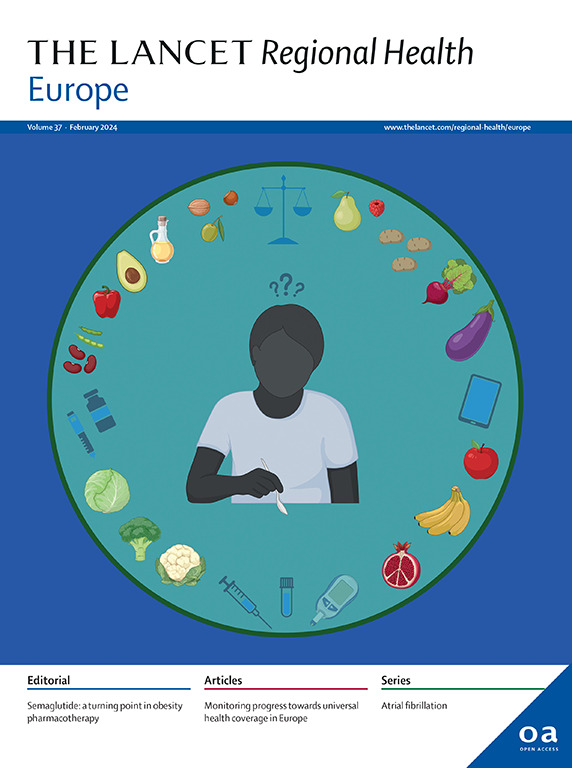丹麦和瑞典儿童癌症幸存者中COVID-19感染和严重程度:一项基于登记的队列研究,匹配人群和兄弟姐妹比较
IF 13
Q1 HEALTH CARE SCIENCES & SERVICES
引用次数: 0
摘要
背景在2019冠状病毒病大流行期间,弱势群体面临着更高的COVID-19严重后果风险。大流行对成年儿童癌症幸存者的影响是一个重大的公共卫生问题,但尚未得到充分了解。我们的目的是评估成年儿童癌症幸存者患严重COVID-19和登记的COVID-19感染的风险是否高于普通人群。方法:这项北欧基于登记的队列研究纳入了丹麦和瑞典20岁前诊断出的5年儿童癌症幸存者,这两个国家对大流行的反应截然不同。作为比较,我们从一般人群中随机选择个体,匹配出生年份、性别和国家,并确定幸存者的所有兄弟姐妹。所有在2020年1月1日至少20岁且在世的人都被跟踪到2022年12月31日。我们绘制了重症COVID-19和登记COVID-19感染的累积危险率,并拟合Cox比例风险模型,估计校正风险比(aHR), 95%置信区间(95% CI)。研究结果包括13659名癌症幸存者,58,803名匹配对照,以及17,531名兄弟姐妹。儿童癌症幸存者登记的COVID-19感染风险较低(aHR = 0.91;95% CI = 0.89 - 0.94),但发生严重COVID-19的风险较高(aHR = 1.58;95% ci = 1.25 - 1.98)。后者在病毒广泛传播期间尤为明显,这反映在丹麦和瑞典之间的差异上。这些发现强调了儿童癌症幸存者的高度脆弱性,甚至在他们被诊断出癌症多年后,并强调需要进行更密切的监测和量身定制的干预措施,以在未来的健康危机中保护这一人群。资助丹麦和瑞典儿童癌症基金会,丹麦国家儿童癌症研究中心,瑞典研究委员会和NordForsk。本文章由计算机程序翻译,如有差异,请以英文原文为准。
COVID-19 infection and severity among childhood cancer survivors in Denmark and Sweden: a register-based cohort study with matched population and sibling comparisons
Background
During the COVID-19 pandemic, vulnerable groups faced a higher risk of severe COVID-19 outcomes. The effect of the pandemic on adult childhood cancer survivors is a significant public health concern but not sufficiently understood. We aimed to assess whether adult childhood cancer survivors had a higher risk of severe COVID-19 and registered COVID-19 infections compared to the general population.
Methods
This Nordic register-based cohort study included 5-year childhood cancer survivors diagnosed before age 20 years in Denmark and Sweden, two countries with very different pandemic responses. As comparisons, we randomly selected individuals from the general population, matched on year of birth, sex, and country, and identified all siblings of the survivors. All individuals at least 20 years old and alive on January 1, 2020, were followed until December 31, 2022. We plotted the cumulative hazard rates of severe COVID-19 and registered COVID-19 infection and fitted Cox proportional hazards models estimating adjusted hazard ratios (aHR) with 95% confidence intervals (95% CI).
Findings
The cohort included 13,659 cancer survivors, 58,803 matched comparisons, and 17,531 siblings. Childhood cancer survivors had a lower risk of registered COVID-19 infection (aHR = 0·91; 95% CI = 0·89–0·94) compared to their comparisons but a higher risk of severe COVID-19 (aHR = 1·58; 95% CI = 1·25–1·98). The latter was particularly evident during periods of widespread viral transmission, as reflected in differences between Denmark and Sweden.
Interpretation
These findings underscore the heightened vulnerability of childhood cancer survivors, even many years after their cancer diagnosis, and emphasize the need for closer monitoring and tailored interventions to safeguard this population during future health crises.
Funding
Danish and Swedish Childhood Cancer Foundation, Danish National Research Centre for Childhood Cancer, Swedish Research Council, and NordForsk.
求助全文
通过发布文献求助,成功后即可免费获取论文全文。
去求助
来源期刊

Lancet Regional Health-Europe
Multiple-
CiteScore
19.90
自引率
1.40%
发文量
260
审稿时长
9 weeks
期刊介绍:
The Lancet Regional Health – Europe, a gold open access journal, is part of The Lancet's global effort to promote healthcare quality and accessibility worldwide. It focuses on advancing clinical practice and health policy in the European region to enhance health outcomes. The journal publishes high-quality original research advocating changes in clinical practice and health policy. It also includes reviews, commentaries, and opinion pieces on regional health topics, such as infection and disease prevention, healthy aging, and reducing health disparities.
 求助内容:
求助内容: 应助结果提醒方式:
应助结果提醒方式:


